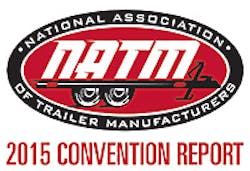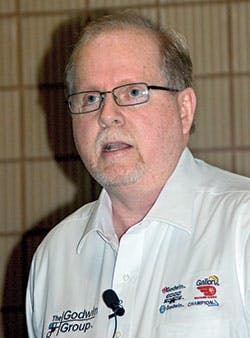PAT Godwin Jr knows his hoists. Champion Hoist & Equipment Co, one of the companies owned by Godwin Manufacturing of Dunn, North Carolina, has tripled its business in the past two years.
So Godwin presented a primer on hydraulics on trailers and how to integrate them at this year’s NATM convention.
He said telescopic hoists (front and under mount) are usually single-acting. Direct mount/pusher (single or dual cylinder) can be single- or double-acting, and conversion/scissors can be single- or double-acting.
“Those are commodity-type cylinders, or catalog cylinders. There are people who make those cylinders like popcorn. They’re very inexpensive and a decent cylinders. The two basic cylinders are welded and tie rod. Welded tends to be more expensive. It tends to be a higher pressure rating than a tie rod cylinder, for the most part. A welded cylinder has more to it in the machining process to get it produced and manufactured. Tie rod is a simpler process. You see a lot of tie rod cylinders in the ag market.”
He evaluated the advantages and disadvantages of the three types of hoists:
• Telescopic.
“It’s 100% efficient because it’s mounted at the front of the bed, and you have a hinge at the rear of the bed, and pressure is pushing directly against the load. A telescopic cylinder is standing straight up. You have 50% of the load on the cylinder and 50% on the rear hinge.
“It lifts the bed at a perpendicular angle. It’s the least amount of pressure to get the most amount of work done. Because we have a cylinder at the front, it takes a small amount of pressure to raise a pretty good size load. In the truck side, the pressure rating is about 1500-2000 psi. With some of the trailers I’ve seen, you probably have as little as 1000 psi. The lower my pressure is on my system, the higher the flow I can have. I can put a bigger pump on it if my pressure is down.
“There are multiple seals, so a slower cycle time. You have a long stroke on that telescopic. Proportionately it will move a little bit faster as far as the speed side. You have to extend this thing way out. So the key is to be on the slow side as far as cycle time. A larger oil reservoir is a must because it’s single-acting.
“The stages are not chrome-plated. If you don’t tell customers about this, you will get complaints. Now you can find front-mount telescopic cylinders that are chrome-plated, but that adds to the cost. Of all the telescopic cylinders in the US, 90% are not chrome-plated.
“Be wary of dump angles. When I start raising this bed, it takes the most amount of pressure just to get the lift started. As the lift starts going up and tilting the bed, we’re transferring weight. That weight has shifted.
“It’s the most unstable design. Think about a three-wheel golf cart—we don’t see those like we used to. There are three points of contact. The trailer starts rocking back and forth, and the telescopic cylinder tends not to be as stable. On the truck side, we have a hoist stabilizer. It bolts around the barrel of the telescopic cylinder and goes down to an elongated pin at the bottom and helps hold that cylinder to keep it from rocking back and forth.”
• Direct mount/pusher.
“In the trailer industry, this is the most common. They’re very efficient and inexpensive. There is design simplicity. We’re anchoring it to the frame of the trailer and underneath the bed, and pushing directly against it.
“It utilizes commodity type cylinders at a lower cost. There are single- or dual-cylinder variations.
“It’s possible to reduce the oil reservoir size if you make efficient engineering designs. On the reservoir itself, we run two lines to the cylinder. On a single-acting, a lot of people put a vent plug in the top of the cylinder. You have to have a larger reservoir because you can’t use the top of the cylinder as a reservoir. It’s better to do it the other way.
“About 70% of energy is directed to the rear hinge, only 30% to the lift. It requires a more robust frame, bed, and hinge design, especially the single-cylinder. Be wary of dump angles with a single-acting having weight shift. It may twist.”
• Conversion/scissor.
“It has faster cycle times and a longer battery life—more dumps per charge. It’s the most stable of all common designs because it has virtually no twist. It spreads the lift point, and there’s not a single lift point.
“Energy is contained within the hoist frame for lift. Higher pressures are required. It has added weight over other hoist designs, is typically more expensive, and lubrication is important.” ♦
About the Author
Rick Weber
Associate Editor
Rick Weber has been an associate editor for Trailer/Body Builders since February 2000. A national award-winning sportswriter, he covered the Miami Dolphins for the Fort Myers News-Press following service with publications in California and Australia. He is a graduate of Penn State University.


